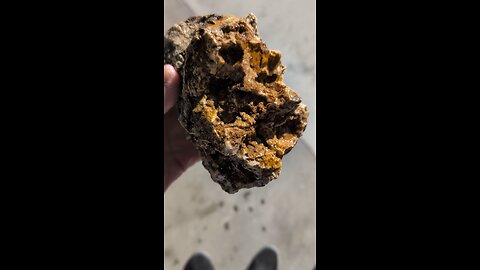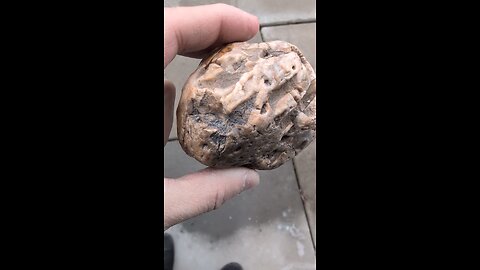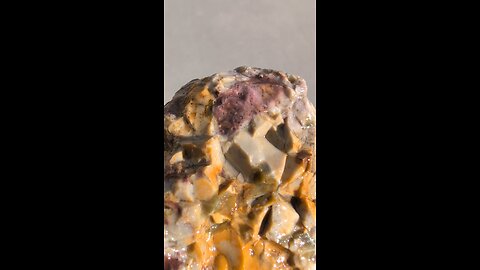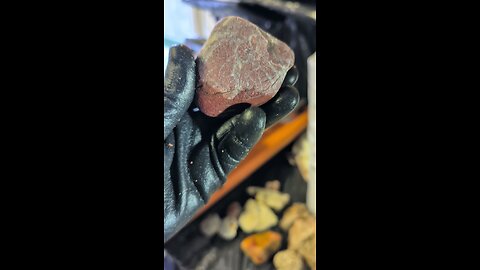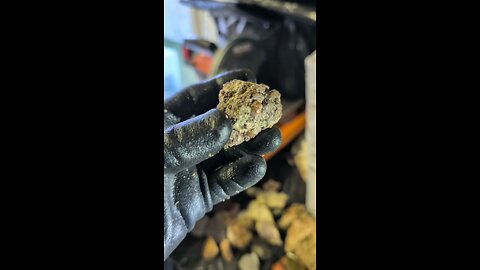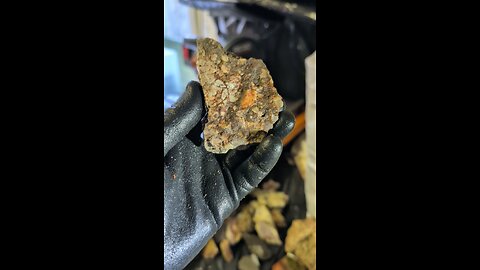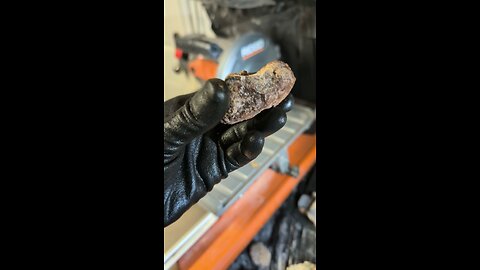
Breccia!
7 videos
Updated 7 months ago
Breccia is a rock composed of angular fragments cemented together in a finer-grained matrix. Here's a detailed look at breccia:
Formation:
Geological Processes: Breccia forms through several mechanisms:
Tectonic Activity: Fault breccias result from the grinding and fracturing of rock along fault lines.
Impact Events: Meteorite impacts can create impact breccia, where the shockwave shatters and then cements rock fragments back together.
Sedimentary Deposition: Sedimentary breccia forms when angular rock fragments are transported by gravity (like in landslides or rock falls) and then cemented.
Volcanic Activity: Volcanic breccias are formed from explosive eruptions where fragments of the volcano or surrounding rock are ejected and then cemented by volcanic ash or other material.
Cementation: The matrix that binds the fragments can be composed of various minerals like calcite, silica, or iron oxides, depending on the environmental conditions at the time of formation.
Characteristics:
Texture: The defining feature is the presence of angular, sharp-edged fragments, distinguishing it from conglomerate, which has rounded clasts.
Composition: Breccia can be made up of any rock type, depending on what was fragmented during its formation. Common components include limestone, basalt, granite, etc.
Color and Appearance: Varies widely based on the source of the clasts and the cementing material. It can range from light to dark, often showing a mottled or patchwork appearance.
Types:
Fault Breccia: Formed by fault movement.
Impact Breccia: Resulting from meteorite impacts.
Sedimentary Breccia: From depositional processes like debris flows.
Volcanic or Igneous Breccia: Associated with volcanic activity.
Uses:
Ornamental Stones: Some varieties, especially when the matrix contrasts with the clasts, can be used for decorative purposes like countertops, tiles, or sculptures.
Construction: Historically used in buildings, particularly for its aesthetic qualities or when local rock was abundant.
Geological Studies: Breccias can provide insights into past geological events, being indicative of tectonic activity, impact events, or ancient landscapes.
Considerations:
Durability: The durability of breccia varies; it depends on the strength of the matrix and the clasts. Some types might be more porous or less resistant to weathering than others.
Identification: In geological fieldwork, identifying the type of breccia can help reconstruct past geological activities.
Cultural and Historical: In archaeology, breccia can be found in ancient structures, providing clues about construction materials and techniques of past civilizations.
Breccia's varied formation processes make it a fascinating rock for both its geological significance and its potential uses in construction and decoration. However, its properties can be quite variable, affecting how it's used or studied.
-
Brecciated Jasper w/Chalcedony!
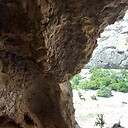 HumbleConservativeBased on the image provided, the rock appears to be a type of jasper, specifically a brecciated jasper. Jasper is known for its rich, earthy colors and often contains patterns or inclusions. Brecciated jasper is characterized by its fragmented appearance, where pieces of jasper are cemented together with silica or other minerals, creating a mosaic-like pattern. This specimen shows a mix of red, brown, and some lighter inclusions, which is typical of jasper. Jasper is an opaque variety of chalcedony and is commonly found in various colors due to impurities like iron.50 views 1 comment
HumbleConservativeBased on the image provided, the rock appears to be a type of jasper, specifically a brecciated jasper. Jasper is known for its rich, earthy colors and often contains patterns or inclusions. Brecciated jasper is characterized by its fragmented appearance, where pieces of jasper are cemented together with silica or other minerals, creating a mosaic-like pattern. This specimen shows a mix of red, brown, and some lighter inclusions, which is typical of jasper. Jasper is an opaque variety of chalcedony and is commonly found in various colors due to impurities like iron.50 views 1 comment -
Hot mess!
 HumbleConservativeBased on the appearance of the rock in the image, it looks like a type of geode or vesicular basalt. Here's why: Vesicular Basalt: The rock has a rough, porous texture with numerous cavities, which is characteristic of vesicular basalt. This type of basalt forms when lava with dissolved gases cools quickly at the surface, trapping gas bubbles as vesicles. The brown and yellowish coloration could be due to oxidation of iron within the rock. Geode: Alternatively, it could be a grouping of crushed geodes, which are a hollow, vaguely spherical rock, often lined with crystals inside. The outer surface of your rock looks somewhat rough and earthy, which is typical for the interior of a geode before it's been cut or broken open to reveal the crystals inside.23 views
HumbleConservativeBased on the appearance of the rock in the image, it looks like a type of geode or vesicular basalt. Here's why: Vesicular Basalt: The rock has a rough, porous texture with numerous cavities, which is characteristic of vesicular basalt. This type of basalt forms when lava with dissolved gases cools quickly at the surface, trapping gas bubbles as vesicles. The brown and yellowish coloration could be due to oxidation of iron within the rock. Geode: Alternatively, it could be a grouping of crushed geodes, which are a hollow, vaguely spherical rock, often lined with crystals inside. The outer surface of your rock looks somewhat rough and earthy, which is typical for the interior of a geode before it's been cut or broken open to reveal the crystals inside.23 views -
Brecciated Jasper!
 HumbleConservativeThe rock in the image appears to be Jasper, specifically a variety that's often called "Picture Jasper" or "Landscape Jasper" due to its interesting patterns. Here's why: * Appearance: The rock exhibits a wide range of earthy tones – yellows, browns, grays, and whites – swirled and banded together. This is characteristic of jasper. * Opacity: Jasper is typically an opaque rock, and the image shows that light doesn't transmit through it. * Texture: While we can't feel the texture from the image, jasper is usually fine-grained and smooth. * Patterns: The distinctive dendritic (branching) patterns and flow-like swirls are common in Picture Jasper. These patterns are often formed by mineral inclusions, such as iron oxides, during the rock's formation. Picture Jasper is a type of chalcedony (a microcrystalline quartz) that is known for its unique and often beautiful patterns. It's a popular material for cabochons, carvings, and jewelry. It's important to note: Identification based on an image alone isn't always definitive. A closer examination in person, including hardness tests and potentially looking at a fresh broken surface, would provide more certainty. However, Jasper, particularly Picture Jasper, is a very likely and accurate identification based on the visual evidence.45 views
HumbleConservativeThe rock in the image appears to be Jasper, specifically a variety that's often called "Picture Jasper" or "Landscape Jasper" due to its interesting patterns. Here's why: * Appearance: The rock exhibits a wide range of earthy tones – yellows, browns, grays, and whites – swirled and banded together. This is characteristic of jasper. * Opacity: Jasper is typically an opaque rock, and the image shows that light doesn't transmit through it. * Texture: While we can't feel the texture from the image, jasper is usually fine-grained and smooth. * Patterns: The distinctive dendritic (branching) patterns and flow-like swirls are common in Picture Jasper. These patterns are often formed by mineral inclusions, such as iron oxides, during the rock's formation. Picture Jasper is a type of chalcedony (a microcrystalline quartz) that is known for its unique and often beautiful patterns. It's a popular material for cabochons, carvings, and jewelry. It's important to note: Identification based on an image alone isn't always definitive. A closer examination in person, including hardness tests and potentially looking at a fresh broken surface, would provide more certainty. However, Jasper, particularly Picture Jasper, is a very likely and accurate identification based on the visual evidence.45 views -
Brecciated Jasper!
 HumbleConservativeBrecciated Jasper is a form of jasper, which is a variety of chalcedony, a microcrystalline quartz. Here's what characterizes brecciated jasper: Appearance: Brecciated jasper has a distinctive look due to its formation process. It consists of angular, sharp-edged fragments (breccia) of jasper cemented together by another mineral, often more jasper or quartz. This creates a mosaic-like pattern where you can see different colors and textures pieced together, giving it a unique, broken or fragmented appearance. Color: The colors can vary widely but are commonly red, brown, yellow, and sometimes green or black. The matrix or cementing material might contrast with the fragments, enhancing the visual appeal. Formation: Brecciation occurs when rocks are broken into fragments by geological processes like faulting, weathering, or other forms of tectonic activity. These fragments are then cemented back together over time by mineral-rich fluids. In the case of brecciated jasper, the fragments are jasper, and they're often cemented by the same or similar mineral composition. Properties: Hardness: Like all jasper, brecciated jasper has a hardness of about 6.5 to 7 on the Mohs scale, making it suitable for various types of jewelry and decorative items. Luster: It typically has a waxy to dull luster when unpolished, but polishing can bring out a more vitreous shine. Uses: Jewelry: Due to its attractive patterns and colors, brecciated jasper is often used in beads, cabochons, and other ornamental pieces. Decorative Stones: It's also used in carvings, decorative stones, and sometimes in architecture for its aesthetic appeal. Metaphysical Properties: In the realm of crystal healing or metaphysical beliefs, brecciated jasper is thought to combine the properties of jasper (grounding, stabilizing) with the energizing effects of hematite if present, promoting physical vitality and emotional stability. Geographical Locations: Brecciated jasper can be found in various parts of the world where jasper is abundant, including but not limited to the United States, particularly in states like Oregon, Idaho, and Arizona, as well as in Brazil and India. When collecting or purchasing brecciated jasper, enthusiasts look for pieces with clear patterns, vibrant colors, and interesting contrasts between the jasper fragments and the matrix. Remember, the exact appearance can vary greatly from one location to another due to differences in the minerals involved and the geological history of the area where it was formed.69 views
HumbleConservativeBrecciated Jasper is a form of jasper, which is a variety of chalcedony, a microcrystalline quartz. Here's what characterizes brecciated jasper: Appearance: Brecciated jasper has a distinctive look due to its formation process. It consists of angular, sharp-edged fragments (breccia) of jasper cemented together by another mineral, often more jasper or quartz. This creates a mosaic-like pattern where you can see different colors and textures pieced together, giving it a unique, broken or fragmented appearance. Color: The colors can vary widely but are commonly red, brown, yellow, and sometimes green or black. The matrix or cementing material might contrast with the fragments, enhancing the visual appeal. Formation: Brecciation occurs when rocks are broken into fragments by geological processes like faulting, weathering, or other forms of tectonic activity. These fragments are then cemented back together over time by mineral-rich fluids. In the case of brecciated jasper, the fragments are jasper, and they're often cemented by the same or similar mineral composition. Properties: Hardness: Like all jasper, brecciated jasper has a hardness of about 6.5 to 7 on the Mohs scale, making it suitable for various types of jewelry and decorative items. Luster: It typically has a waxy to dull luster when unpolished, but polishing can bring out a more vitreous shine. Uses: Jewelry: Due to its attractive patterns and colors, brecciated jasper is often used in beads, cabochons, and other ornamental pieces. Decorative Stones: It's also used in carvings, decorative stones, and sometimes in architecture for its aesthetic appeal. Metaphysical Properties: In the realm of crystal healing or metaphysical beliefs, brecciated jasper is thought to combine the properties of jasper (grounding, stabilizing) with the energizing effects of hematite if present, promoting physical vitality and emotional stability. Geographical Locations: Brecciated jasper can be found in various parts of the world where jasper is abundant, including but not limited to the United States, particularly in states like Oregon, Idaho, and Arizona, as well as in Brazil and India. When collecting or purchasing brecciated jasper, enthusiasts look for pieces with clear patterns, vibrant colors, and interesting contrasts between the jasper fragments and the matrix. Remember, the exact appearance can vary greatly from one location to another due to differences in the minerals involved and the geological history of the area where it was formed.69 views -
Brecciated Jasper Cut!
 HumbleConservativeBrecciated Jasper is a type of jasper that is characterized by its appearance as broken fragments or pieces of jasper that have been naturally cemented together. Here's a more detailed explanation: Formation: Brecciated Jasper forms when existing jasper is fractured or broken into pieces due to geological processes like tectonic activity or weathering. These fragments are then cemented together by silica or other minerals, often quartz, which fills the spaces between the fragments. Appearance: It typically has a distinctive, mosaic-like pattern where the jasper fragments are angular and vary in size, creating a visually striking contrast with the matrix that holds them together. The colors can range from red, brown, yellow, to white, depending on the impurities present in the jasper and the matrix material. Uses: Due to its unique and attractive pattern, Brecciated Jasper is commonly used in jewelry, carvings, and decorative items. It's valued for its aesthetic appeal and the interesting geological story it65 views
HumbleConservativeBrecciated Jasper is a type of jasper that is characterized by its appearance as broken fragments or pieces of jasper that have been naturally cemented together. Here's a more detailed explanation: Formation: Brecciated Jasper forms when existing jasper is fractured or broken into pieces due to geological processes like tectonic activity or weathering. These fragments are then cemented together by silica or other minerals, often quartz, which fills the spaces between the fragments. Appearance: It typically has a distinctive, mosaic-like pattern where the jasper fragments are angular and vary in size, creating a visually striking contrast with the matrix that holds them together. The colors can range from red, brown, yellow, to white, depending on the impurities present in the jasper and the matrix material. Uses: Due to its unique and attractive pattern, Brecciated Jasper is commonly used in jewelry, carvings, and decorative items. It's valued for its aesthetic appeal and the interesting geological story it65 views -
Brecciated Jasper Cut!
 HumbleConservativeBrecciated Jasper is a type of jasper that is characterized by its appearance as broken fragments or pieces of jasper that have been naturally cemented together. Here's a more detailed explanation: Formation: Brecciated Jasper forms when existing jasper is fractured or broken into pieces due to geological processes like tectonic activity or weathering. These fragments are then cemented together by silica or other minerals, often quartz, which fills the spaces between the fragments. Appearance: It typically has a distinctive, mosaic-like pattern where the jasper fragments are angular and vary in size, creating a visually striking contrast with the matrix that holds them together. The colors can range from red, brown, yellow, to white, depending on the impurities present in the jasper and the matrix material. Uses: Due to its unique and attractive pattern, Brecciated Jasper is commonly used in jewelry, carvings, and decorative items. It's valued for its aesthetic appeal and the interesting geological story it46 views
HumbleConservativeBrecciated Jasper is a type of jasper that is characterized by its appearance as broken fragments or pieces of jasper that have been naturally cemented together. Here's a more detailed explanation: Formation: Brecciated Jasper forms when existing jasper is fractured or broken into pieces due to geological processes like tectonic activity or weathering. These fragments are then cemented together by silica or other minerals, often quartz, which fills the spaces between the fragments. Appearance: It typically has a distinctive, mosaic-like pattern where the jasper fragments are angular and vary in size, creating a visually striking contrast with the matrix that holds them together. The colors can range from red, brown, yellow, to white, depending on the impurities present in the jasper and the matrix material. Uses: Due to its unique and attractive pattern, Brecciated Jasper is commonly used in jewelry, carvings, and decorative items. It's valued for its aesthetic appeal and the interesting geological story it46 views -
Breccia!
 HumbleConservativeBreccia is a clastic sedimentary rock characterized by its composition of angular fragments or clasts that are cemented together. Here are some key details about breccia: Formation: Breccia forms in environments where there is little to no transportation of the rock fragments after they are broken off from their source. This can occur in several settings: Talus Slopes: At the base of cliffs where rockfalls occur, and the fragments accumulate with minimal movement. Fault Zones: Where tectonic forces break rocks, and the fragments are cemented in place. Volcanic Eruptions: Around volcanic vents where explosive eruptions eject angular volcanic material. Submarine Landslides: In underwater environments where landslides deposit broken rock. Composition: Clasts: These are the angular fragments, which can be composed of various rock types like limestone, quartzite, or volcanic rocks. Matrix: The finer material, often sand, silt, or clay, that fills the spaces between the clasts. Cement: Minerals like calcite, sili46 views
HumbleConservativeBreccia is a clastic sedimentary rock characterized by its composition of angular fragments or clasts that are cemented together. Here are some key details about breccia: Formation: Breccia forms in environments where there is little to no transportation of the rock fragments after they are broken off from their source. This can occur in several settings: Talus Slopes: At the base of cliffs where rockfalls occur, and the fragments accumulate with minimal movement. Fault Zones: Where tectonic forces break rocks, and the fragments are cemented in place. Volcanic Eruptions: Around volcanic vents where explosive eruptions eject angular volcanic material. Submarine Landslides: In underwater environments where landslides deposit broken rock. Composition: Clasts: These are the angular fragments, which can be composed of various rock types like limestone, quartzite, or volcanic rocks. Matrix: The finer material, often sand, silt, or clay, that fills the spaces between the clasts. Cement: Minerals like calcite, sili46 views
